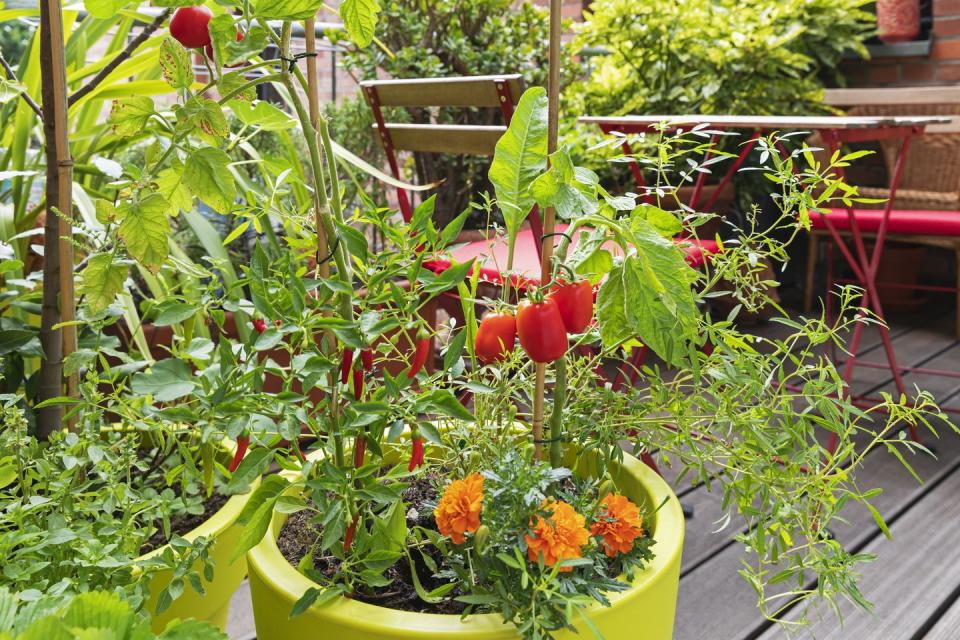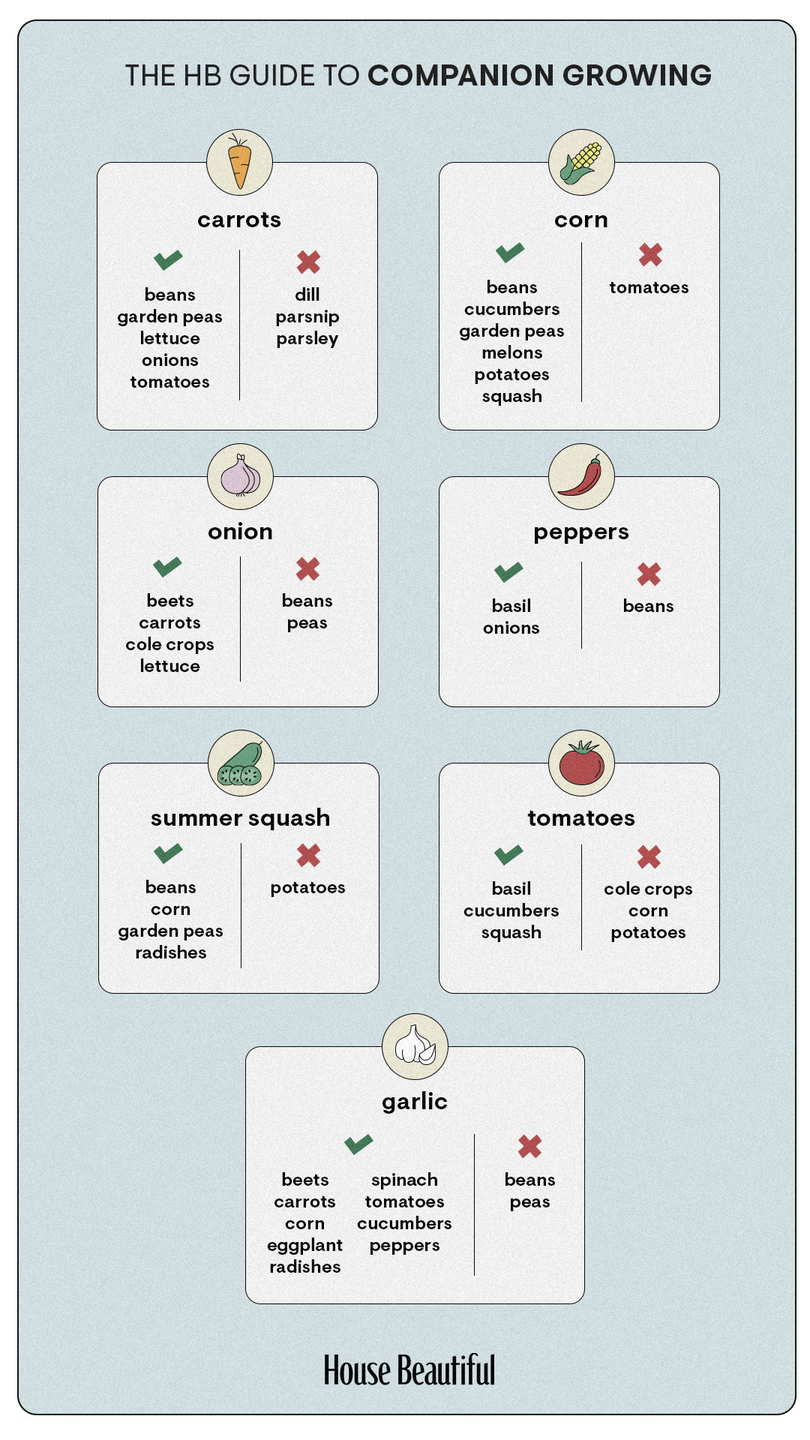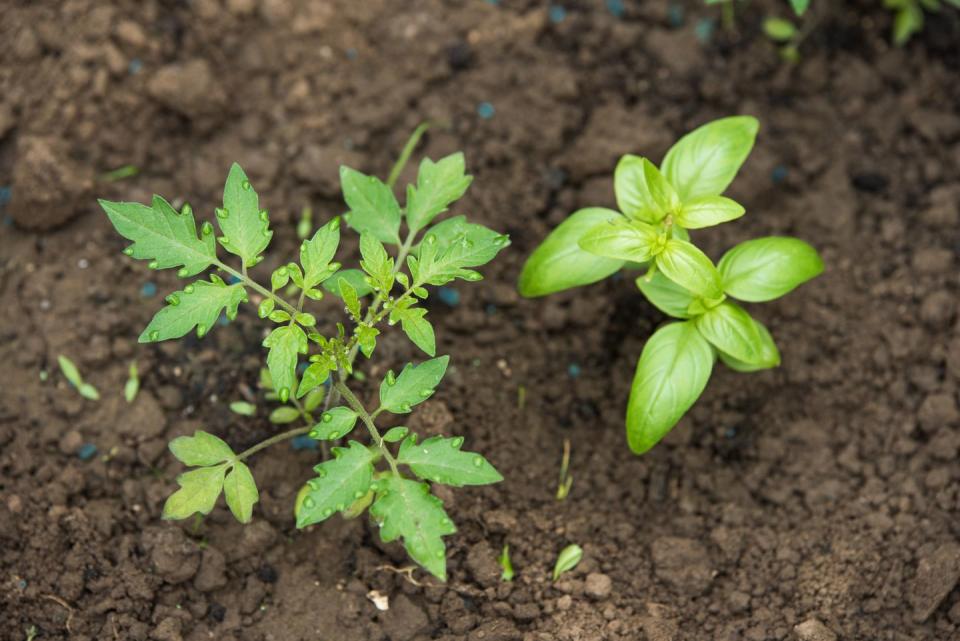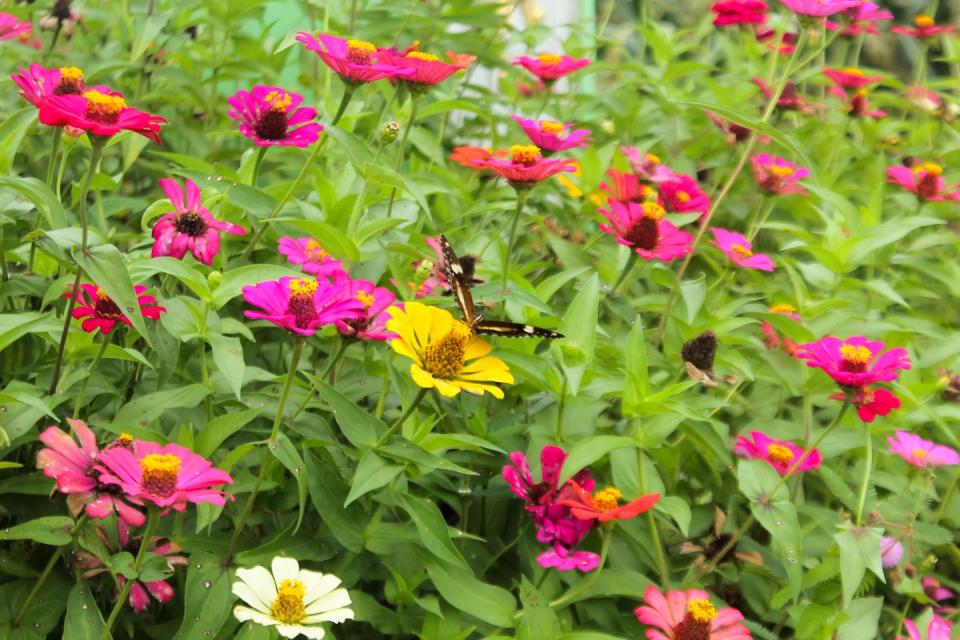This Gardening Technique Keeps Pests Away Naturally
"Hearst Magazines and Yahoo may earn commission or revenue on some items through these links."
Growing a thriving garden takes time, effort, and plenty of patience, but there are a few things you can do to set yourself up for success. Understanding the type of soil your plants prefer, how much sun they require, and how much water they need are all keys to successful gardening. Pairing plants with mutually beneficial crops—also known as companion growing—is another tried-and-true way to grow the best garden possible. Planting the right crops next to each other not only helps each plant thrive, but it can also deter pests and attract pollinators.
To understand what is companion growing, we reached out to landscape designer and certified horticulturist Melanie Rekola and ISA certified arborist Andrea Doonan. Read on to learn everything you need to know about companion planting and get our companion gardening chart to try it out at home.
What Is Companion Growing?
“Companion planting is the act of growing certain plants together, usually for their mutual benefit,” Rekola, owner of Melanie Rekola Landscape Design in Ontario, Canada, explains. This practice is particularly well suited to edible plants and vegetable gardens that may attract pests. Choosing the right companion plants can help keep pesky animals and inspect away from your crops and allow them to ripen. But keep in mind that some plants don’t make great companions and therefore should not be planted next to each other. Rekola calls out potatoes and zucchini as two popular plants in particular that should not be planted close together. “Both are fast growers, but the potatoes deplete the soil’s nutrients quickly,” she explains. “This leaves the zucchini plants struggling to get what they need to flourish.”
Companion growing is also said to improve the flavor of some plants, though scientific evidence of that is lacking, according to Doonan, owner of Andrea Doonan Horticulture + Design in San Diego. That said, many avid home gardeners and the Farmers’ Almanac praise the practice.
Benefits of Companion Growing

There are multiple use cases for companion growing, according to Doonan. She explains that you can grow companion crops near edible plants to draw pests—typically insects—away from your main crop. This practice, also known as “trap cropping,” essentially sacrifices the secondary crop for the health of the primary one. Doonan says it’s a favorite tactic among organic strawberry farmers. It’s been shown to cut down on the need for insecticide, according to the University of Missouri’s Integrated Pest Management department.
But drawing insects away from plants is far from the only benefit of companion growing. Doonan says many companion plants can “attract beneficial insects,” and flowering plants in particular can “attract pollinators to improve the yield and health of plants and crops.” Companion planting can also be used to improve the quality of your soil. Doonan notes that both nitrogen-fixing plants and cover crops “can return nutrients to the soil.”
Companion Gardening Chart
When deciding which plants to grow near each other, it’s important to keep their specific needs in mind. “A good rule of thumb when planting different kinds of plants together is that they must have similar water and soil needs so that all the plant types can thrive,” Rekola says. Ready to try your hand at companion planting? These popular combinations are a great place to start.

Companion Growing to Deter Pests

Keeping pests away from crops—especially edible crops like vegetables—is one of the most popular reasons people try companion growing. Choosing fragrant companion plants will help deter pests from your crops, according to Rekola. “Adding strong-smelling onions and herbs like sage and oregano to a veggie garden repels pests and protects the other plants,” she explains.
There are certain duos that work particularly well together to deter pests, namely tomatoes and basil. (That’s right, they don’t just make a great duo in the kitchen but the garden as well). “Basil repels certain insects that eat the tomato plants and improves the tomatoes’ flavor too,” Rekola says.
There are plenty of other herbs and flowers known for repelling pests, including the crops below:
Cilantro
Sage
Thyme
Chives
Dill
Garlic
Oregano
Petunias
Marigolds
Chrysanthemums
Borage
Chamomile
Companion Growing to Attract Pollinators

Companion growing can also be used to significantly improve your garden’s productivity. Rekola explains that the more pollinators—like bees, hummingbirds, and butterflies—that visit your garden, the better it will perform. “By adding flowering plants or letting your herbs flower, you’ll attract more pollinators to the veggie garden, making it up to 30 percent more productive,” she says.
The following companion herbs and flowers are particularly well-known for their ability to attract pollinators:
Rosemary
Nasturtium
Basil
Calendula
Zinnias
Snapdragons
Sunflowers
Mint
Borage
Marigolds
Cosmos
Companion Growing Mistakes to Avoid
While deciding which plants to pair is the most important part of companion growing, there are a few other things to keep in mind.
Spacing Companion Plants Too Far Apart
Rekola says this is one of the biggest mistakes she sees gardeners make. “When plants are grown more tightly together, they protect the soil from drying sun and suppress weed growth,” she explains. “And when plants are grown in proximity, they share resources through their roots, which benefits all the plants.” Ideally, companion plants should be sown within two or three rows of each other, according to the University of West Virginia Extension.
Putting Incompatible Plants Too Close Together
Gardeners should avoid placing plants that don’t grow well together—like potatoes and zucchini, parsley and carrots, or corn and tomatoes—in close proximity, Rekola says. Keep them at least two to three rows apart.
Pairing Plants That Can Share Diseases
Crops that are prone to the same diseases should be planted apart in an effort to cut down on disease spread. Examples include anthracnose, a disease caused by fungi that affects beans, tomatoes, cucumbers, and watermelon, and clubroot, which targets cabbage, turnips, Brussels sprouts, and cauliflower, according to the University of Minnesota Extension.
Companion Growing FAQs
What Is the Rule of Three for Companion Growing?
This companion growing technique, also sometimes called the three sisters companion plants, refers to a Native American method for growing corn, pole beans, and squash together, according to the University of Delaware Cooperative Extension. The plants benefit each other: The corn provides a natural trellis for the beans to climb, the big squash leaves provide shade that deters weeds, and the beans put nitrogen back into the soil.
Can I Use Companion Planting in a Container Garden?
Yes, companion planting works well even in small containers when you choose the right plants, according to the University of West Virginia Extension, which suggests combining tomatoes, peppers, lettuce, onions, basil, and oregano in the same large container to grow a salad garden or pizza garden.
How Close Is Considered Companion Planting?
To get the benefits of companion planting, grow companion plants within two or three rows of each other, according to the University of West Virginia Extension.
Follow House Beautiful on Instagram and TikTok.
You Might Also Like

